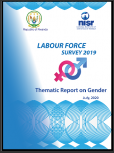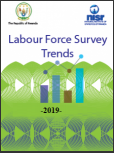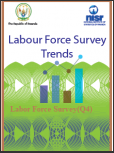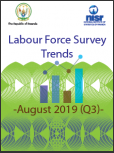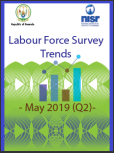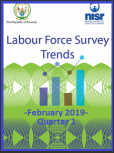Publications
Labour Force Survey 2019, Thematic Report, Gender
This report is the result of the analysis of Labour Force Survey 2019. It sets out a broad overview of trends and gender gaps, including gaps in labour force participation rates, employment-to-population ratios and unemployment rates, along with differences in labour market status and the type of activities that men and women perform in the labour market, hours spent in paid and unpaid work and sectoral and occupational segregation. It also discusses the extent to which these factors account for gender gaps in wages and social protection.
Labour Force Survey Annual Report 2019
The Rwanda Labour Force survey programme begun in 2016 with an annual sample spread into two rounds to provide bi-annual estimates of main indicators at the National level. From February 2019, the annual sample was spread into four rounds to provide estimates of main labour market indicators on quarterly basis at the National level.
Labour Force Survey Trends-November 2019(Q4)
The sample design of labour force survey presents an advantage of estimating trend of labour market indicators with a higher precision due to its rotational design. In this report, the survey results are compared for February 2019 (Q1), May 2019 (Q2), August 2019 (Q3) and November (Q4). The current report presents in some cases data points including results of the labour force surveys in the previous year.
Labour Force Survey Trends-August 2019(Q3)
The sample design of labour force survey presents an advantage of estimating trend of labour market indicators with a higher precision due to its rotational design. In this report, the survey results are compared for February 2019 (Q1), May 2019 (Q2) and August 2019 (Q3). However, tables are presented in most cases with more data points including results of the labour force surveys in the previous year.
Labour Force Survey Trends-May 2019(Q2)
The focus of the present report has the objective of providing data on the structure and trends of labour force, employment and unemployment as well as other related labour market statistics for the implementation and evaluation of economic and social policies related to employment creation, income generation, skills development, and related decent work policies at the national by selected demographic and socioeconomic characteristics such as sex, age group, educational attainment, occupation and industry.
Labour Force Survey Trends-February 2019(Q1)
The focus of the present report has the objective of providing data on the structure and trends of labour force, employment and unemployment as well as other related labour market statistics for the implementation and evaluation of economic and social policies related to employment creation, income generation, skills development, and related decent work policies at the national by selected demographic and socioeconomic characteristics such as sex, age group, educational attainment, occupation and industry.

